
Menemerus is a genus of jumping spiders that was first described by Eugène Louis Simon in 1868. They are 4 to 10 millimetres long, flattened in shape, and very hairy, usually with brown and grayish hairs. Most species have white edges on the thorax. The abdomen is often oval, or sometimes elongated or rounded.

Menemerus semilimbatus is a spider in the family Salticidae.

Menemerus davidi is a species of jumping spider in the genus Menemerus that lives in North Africa and the Middle East. The species was first identified in 1999 by Jerzy Prószyński and Wanda Wesołowska working initially independently, and then together. The first description was published by Wesołowska, one of over 500 descriptions she produced during her lifetime. The spider is small, with a carapace that ranges between 2.3 and 3.0 millimetres long and an abdomen that is 2.2 and 3.2 millimetres long, although the female is larger than the male. The carapace is generally a uniform dark brown while the abdomen has a pattern of a light brown stripe and white patches that serves to distinguish it from the related Menemerus animatus. Otherwise, it is its copulatory organs that most distinguish the species from others in the genus. It has distinctive internal structure to the female epigyne. The wide copulatory openings lead down the centre of the spider to the spermathecae while there is also a short narrower channel that runs to the rear of the spider with a prominent scent pore at the end. The male has a noticeably smaller embolus and a distinctive dorsal tibial apophysis.

Menemerus desertus is a species of jumping spider in the genus Menemerus that lives in Algeria. The species was first described in 1999 by Wanda Wesołowska, one of over 500 descriptions she produced during her lifetime. The spider is small, with a carapace that ranges between 2.5 and 2.7 millimetres long and an abdomen that is 2.7 and 4.7 millimetres long, although the female is larger than the male. The carapace is generally a uniform dark brown while the abdomen has a yellow stripe. Otherwise, it is its copulatory organs that most distinguish the species from others in the genus. The female epigyne has ridges at the entrance to the insemination ducts. The male has a distinctive dorsal tibial apophysis.
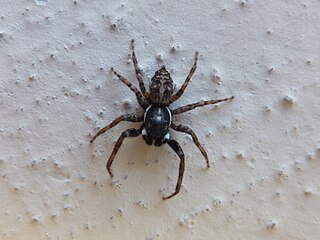
Menemerus guttatus is a species of jumping spider in the genus Menemerus that lives in Morocco. The spider has been found in the High Atlas mountains in gravel rivers. It displays complex courtship patterns. The species was first described in 1999 by Wanda Wesołowska, one of over 500 descriptions she has made during her lifetime. The spider is small, with a dark brown, nearly black carapace that is between 2.8 and 3.5 millimetres long and a dark brown abdomen between 2.5 and 5.6 millimetres long. The female is larger than the male. It can be distinguished from other species in the genus by the pattern on its abdomen, which consists of two lines of white patches that converge to the back of the spider. Otherwise, it is the copulatory organs that most identify the species. The male has a distinctive relatively wide and short embolus and lamella and two similar appendages at the base of the palpal bulb, or apophyses. The female has a complex internal structure of the epigyne including crescent-shaped chambers and circular spermathecae.
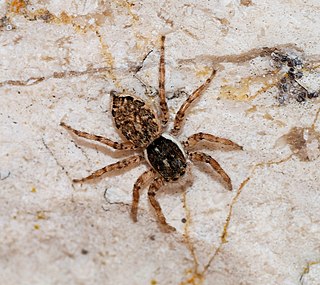
Menemerus bifurcus is a species of jumping spider in the genus Menemerus that lives in South Africa, Zambia and Zimbabwe. The species was first described in 1999 by Wanda Wesołowska, one of over 500 descriptions she has written during her lifetime. The spider lives in groups in Acacia, Combretum, Jacaranda, Spathodea and Trichilia trees as well as in houses and other areas of human habitation. It descends to attack prey on long threads of silk. It is a small spider, with a carapace that is between 1.9 and 2.3 millimetres long and an abdomen between 1.9 and 2.5 millimetres long. The female is larger than the male and generally lighter, ranging generally from fawnish-brown to dark brown. The species is similar to Menemerus formosus and Menemerus transvaalicus but differs in the design of its copulatory organs. The male has a short embolus with a longer lamella, which is recalled in the species name, and two distinctive tibial appendages, or apophyses, one with a characteristic triangular lobe. Examples found in Zimbabwe have one longer tibial apophysis. The female has a heart-shaped depression in the epigyne and an unusual insemination duct morphology.

Menemerus transvaalicus is a species of jumping spider in the genus Menemerus that lives in Lesotho and South Africa. The species was first identified in 1999 by Wanda Wesołowska, one of over 500 descriptions she has written during her lifetime. The spider often lives on Eucalyptus trees and the walls of buildings. It is small, with a dark brown hairy carapace that is between 2.1 and 2.5 millimetres long and a fawn to dark brown abdomen that is between 2.0 and 3.6 millimetres in length. The female is larger than the male. It has a yellowish leaf-shaped pattern on its abdomen and orange to brown legs. The male has a conductor on its double embolus, which helps to distinguish the spider from the related Menemerus bifurcus.

Menemerus formosus is a species of jumping spider in the genus Menemerus that lives in Kenya. The species was first described in 1999 by Wanda Wesołowska, one of over 500 descriptions she has written during her lifetime. It is a small spider, with a brown carapace that is between 2.0 and 2.3 millimetres long, with a darker eye field that is between 1.0 and 1.2 millimetres long, and a yellowish abdomen between 1.9 and 2.3 millimetres long. The female is larger than the male and has a pattern of silver patches on its abdomen. The legs are yellow. The species is similar to Menemerus bifurcus, Menemerus magnificus and Menemerus transvaalicus but differs in the design of its copulatory organs. The male has a conductor that curves over its short embolus. The female has an epigyne that has a shallow depression and a furrow with a wide pocket.

Menemerus minshullae is a species of jumping spider in the genus Menemerus that lives in South Africa, Malawi and Zimbabwe. The species was first described in 1999 by Wanda Wesołowska, one of over 500 descriptions she has completed during her lifetime. She originally identified the male as a different species, named Menemerus manicus, but merged the two in 2007. It is small to medium-sized spider with a cephalothorax that is between 1.9 and 2.2 millimetres long and an abdomen between 2.1 and 3.3 millimetres long. The female is larger than the male and lighter, with a dark brown rather than black carapace and lighter brown abdomen. The abdomen has a large, leaf-shaped, pattern. It lives on Vachellia xanthophloea trees, using its flattened shape to hide under flakes of bark. The copulatory organs distinguish the species from others in the genus. The male has a very short embolus with a larger accompanying conductor. The female epigyne has two pockets that have strongly sclerotized edges.
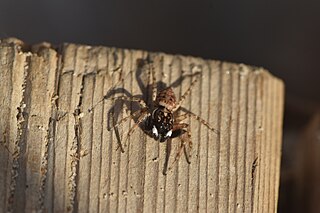
Menemerus meridionalis is a species of jumping spider in the genus Menemerus that lives in South Africa. The species was first described in 1999 by Wanda Wesołowska, one of over 500 descriptions she produced during her lifetime. The spider is small, with a carapace that is typically 2.8 millimetres (0.11 in) long and an abdomen 3.3 millimetres (0.13 in) long. The carapace is generally dark brown with a white stripe down the middle while the abdomen has a dark brown stripe. Otherwise, it is its copulatory organs that most distinguish the species from others in the genus. The male has a lumpy retrolateral tibial apophysis, similar to but smaller than Menemerus tropicus, and a very small spiked ventral tibial apophysis.

Menemerus magnificus is a species of jumping spider in the genus Menemerus that lives in Cameroon. The species was first described in 1999 by Wanda Wesołowska, one of over 500 descriptions she wrote during her lifetime. The spider is small, with a carapace that is typically 1.2 millimetres (0.05 in) long and an abdomen that is 1.8 millimetres (0.07 in) long. The carapace is generally a uniform dark brown while the abdomen has two rows of patches on the back. Otherwise, it is its copulatory organs that most distinguish the species from others in the genus. The male has a distinctive dorsal tibia that includes horn-like appendages, or apophyses, and lobes. The female has not been described.
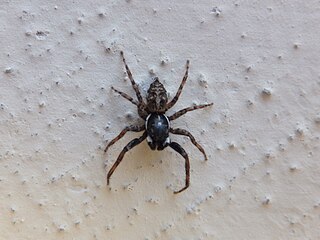
Menemerus mirabilis is a species of jumping spider in the genus Menemerus that lives in Ethiopia in areas of human habitation, including a house and a hotel. The species was first described in 1999 by Wanda Wesołowska. The spider is small and brown, with a carapace that is between 1.8 and 2.4 millimetres long and an abdomen between 2.0 and 3.5 millimetres long. The female has a larger and lighter abdomen than the male. The male has an indistinct leaf-shaped pattern on its abdomen. It is similar to other species in the genus but can be distinguished by its copulatory organs. The male has a shorter embolus than other species. The female can be identified by the two depressions in its epigyne and its circular spermathecae.

Menemerus natalis , the Natal Menemerus Jumping Spider, is a species of jumping spider in the genus Menemerus that lives in South Africa. The species was first described in 1999 by Wanda Wesołowska based on a holotype found in KwaZulu-Natal. The spider is medium-sized, with a carapace that is between 3.1 and 3.3 millimetres long and an abdomen between 2.0 and 2.3 mm long. The carapace is very dark brown, nearly black.while the abdomen is russet-brown. There are three white dots between the eyes on the black eye field. Otherwise, it is its copulatory organs that most distinguish the species from others in the genus. The male has a long embolus and small narrow tibia. The female has not been described.

Menemerus namibicus is a species of jumping spider in the genus Menemerus that lives in Namibia. The species was first described in 1999 by Wanda Wesołowska. It is small to medium-sized spider with a dark brown carapace that is between 2.7 and 3.3 millimetres long and a black abdomen between 3.7 and 4.9 millimetres long. The spider's eye field is also black while the carapace is covered in grey hairs. The spider can be distinguished from others in the genus by its copulatory organs. The female epigyne has a large depression and strongly sclerotized entrance bowls, short insemination ducts and spherical spermathecae. The ridges at the very rear of the depression is characteristic of the species. The male has not been described.

Menemerus zimbabwensis is a species of jumping spider in the genus Menemerus that lives in South Africa and Zimbabwe. The Polish arachnologist Wanda Wesołowska first described the female in 1999 and the male in 2007. The spider is large, with a cephalothorax that is between 1.9 and 3.2 millimetres long and an abdomen that is between 2.1 and 4.6 millimetres in length. The female is larger than the male. It also lacks the light stripe down the centre of its dark brown carapace and has a less distinct pattern on its abdomen. Its legs and pedipalps are yellow, while on the male they are brown. The male can be distinguished from the similar Menemerus nigli by the wide stripe on its abdomen. The female is harder to identify without looking at its copulatory organs. These are distinctive. It has characteristic large entrance bowls on its epigyne, which are larger than the insemination ducts and spermathecae combined. Its internal organs are very sclerotized.

Menemerus soldani is a species of jumping spider in the genus Menemerus that lives in Algeria, Egypt and Tunisia. It was first described in 1826 by Jean Victor Audouin. He identified both the male and female but not in much detail and it was not until 1999 that a thorough description was completed. This led to confusion, with many museums holding examples of different species labelled Menemerus soldani. When the female was described by Hippolyte Lucas and Wanda Wesołowska, they were designated as different species, both of these being declared junior synonyms by subsequent arachnologists. The spider is small, with a total length between 3.11 and 5.65 mm, and has a brown carapace, yellow abdomen and orange legs. The spiders have characteristic copulatory organs. The female has a characteristic semi-circular notch at the rear of its epigyne while the male has a large bulbous patellar apophysis that other species in the genus lack. The male has a flat projection or apophysis on its pedipalp tibia. The spider lives in palm groves and Quercus suber forests.
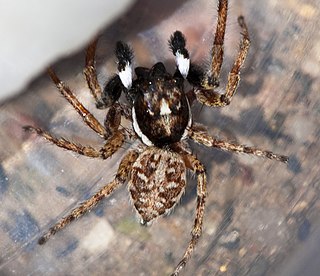
Menemerus pulcher is a species of jumping spider in the genus Menemerus that lives in Mauretania. The species was first described in 1999 by Wanda Wesołowska. The spider is small and brown, with an atypically high carapace that is 2.6 millimetres (0.10 in) long and an abdomen 2.8 millimetres (0.11 in) long. There is a white stripe running down the back of the otherwise brown carapace. The abdomen is yellowish-fawn with a dark pattern that is reminiscent of a fleur-de-lis and more rounded than other spiders in the genus. Otherwise, it is externally similar to Menemerus plenus, although it can be distinguished by its copulatory organs. The male has a double embolus and two large parallel retrolateral apophyses, or appendages. The female has not been described.

Menemerus regius is a species of jumping spider in the genus Menemerus that lives in Ethiopia. The species was first identified in 1999 by Wanda Wesołowska. The spider has been found living in low vegetation, on trees and in houses. It is small, with a brown hairy carapace that is between 1.9 and 2.4 millimetres long and a yellowish-grey or greyish-beige abdomen that is between 2.1 and 3.0 millimetres in length. The female is slightly larger than the male. The carapace has a large yellowish patch and the abdomen a stripe down the middle. The spider has yellow legs. The spider is similar to others in the genus. However, its copulatory organs are distinctive. The male lacks the ventral tibial apophysis normally found on its palpal bulb and instead has an unusual double tibial apophysis with one bulbous appendage and the other shaped like a horn. The female has a characteristic shape to its epigyne with two rounded depressions to the front and a noticeable notch to the rear.
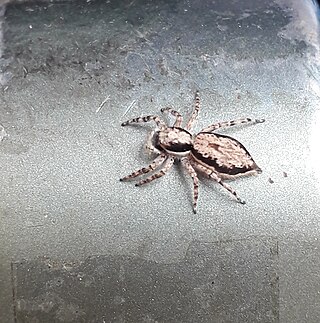
Menemerus nigeriensis is a species of jumping spider in the genus Menemerus that lives in Nigeria. The species was first described in 2011 by Wanda Wesołowska and Anthony Russell-Smith based on a holotype found near Ibadan. The spider is medium-sized, with a cephalothorax that is typically 2.5 millimetres (0.10 in) long and an abdomen 2.6 millimetres (0.10 in) long. The carapace is generally a uniform dark brown, the eye field black and the abdomen greyish-brown. As with other Menemerus spiders, it is its copulatory organs that most distinguish the species from others in the genus. The male has a distinctive dorsal tibia that has a very long and pointed apophysis or appendage. The female has not been identified.

Menemerus nigli is a species of jumping spider in the genus Menemerus that originates in Asia. The male was identified in 2012 by Wanda Wesołowska and Mario Freudenschuss, and the female by Pir Asmat Ali, Wayne Maddison. Muhammad Zahid and Abida Buttin in 2018. The spider is medium-sized, typically 4.89 millimetres (0.193 in) in length, with a dark brown carapace and grey-brown abdomen that has a distinctive cream and white pattern created by small hairs. It was originally found in India, Pakistan and Thailand but was also found to have been introduced into Latin America, the first specimens being identified in Brazil in 2020. It seems to thrive amongst the sunlit stucco walls that are common in cities across the region. Menemerus nigli is used as an example of the ability of species that adapt to human habitation to expand their ecological niche and become global species.















